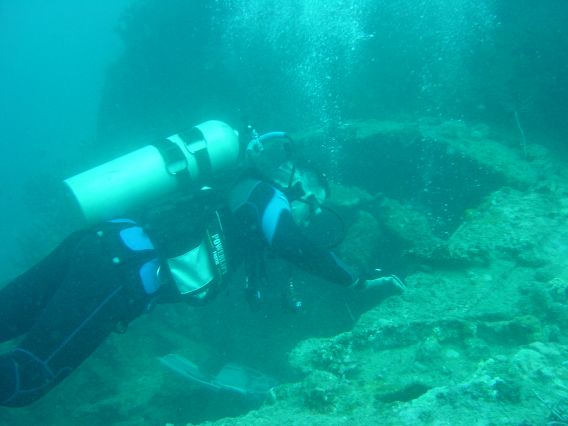 IJN Submarine I-1
IJN Submarine I-1
The big Japanese cruiser submarine I-1
lies on the outside of the reef off Tambea which is a small village about 25
miles (40 km) west of Honiara. The submarine was 320 feet long with an endurance
of 60 days and a range of 24,000 miles. The I-1 ran aground on the reef in
January 1943 after a battle with two New Zealand corvettes. The submarine now
lies with the shattered bow in 15 feet (5 m) and the stern in 100 feet (30 m) of
water.
During a cruise in the Solomons in
September 2004 on the MV Princess II, we anchored off Tambea while two
crewmembers went ashore to pay the custom fee for diving on the wreck. Meanwhile
we geared up on the dive deck and made a plan to dive down to the stern of the
I-1 and then move slowly up the wreck to the shallow reef area.
We could see the long ‘cigar tube’
shape of the aft section of the submarine and swam down the outside to the
stern. The propellers were salvaged in the 1960s and
the rudder is buried in the sand. We swam along the rear deck and I entered the first area where the
hull is fractured. There is a great deal of machinery inside and several large
air cylinders. I swam through a small circular frame which must have once been a
watertight door.
Back on the outside, the conning tower is
nowhere to be seen and the ship itself is severely damaged. The forward half of
the submarine is blown wide open with debris all over the reef.
Apparently the salvagers blew up the bow section which set off some live
torpedoes in the torpedo room! We
finished the dive on the shallow reef where we admired the colourful
anemonefish.
According to Jane’s Fighting Ships of
World War II, the I-1 was 320 feet (97.5 metres) long and had a displacement
of 1955/2480 tons. I-1 was the first of the Junsen class of Japanese ocean-going
submarines and was completed in 1926. The submarine was originally armed with
two 140-mm (5.5-inch) deck guns and had six 21-inch torpedo tubes. Although it
was a big submarine, larger I-class submarines were built before and during
WWII. According
to I-1’s Tabular Record of Movement, it was converted to a
cargo-carrying role in August 1942 by
removing the aft 140-mm (5.5-inch) gun
to make room for mountings to hold a 46-foot landing barge.
On
29 January 1943, the I-1 arrived off the coast with a crew of
82, replacement troops, and a load of
food supplies in rubber containers in the barge on the rear deck. The
submarine was detected by the New Zealand corvettes HMNZS Kiwi and HMNZS
Moa which dropped depth charges forcing it to surface, exchanged
gunfire and rammed it three times. During the battle, the barge of supplies
caught fire and the captain was hit by gunfire. The damaged submarine finally
ran onto the reef off Tambea.
Since the submarine carried code books, the
Japanese armed forces tried to destroy it on several occasions, but failed to
prevent the recovery of the books by the US Navy. However, the submarine
(particularly the bow section) was severely damaged by salvage operations in
search of valuable metals in the 1960s.
A full account of the fate of the I-1 can
be found in the Tabular Record of Movement at the Combined
Fleet website.
Reference: Jane’s Fighting Ships of
World War II.